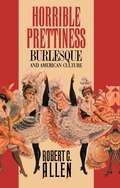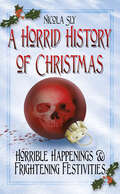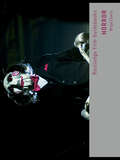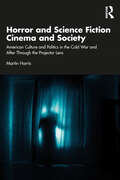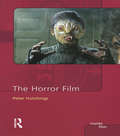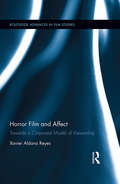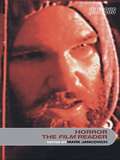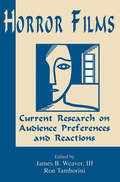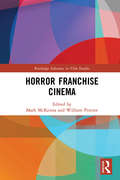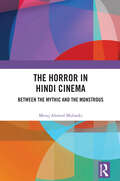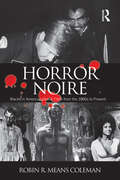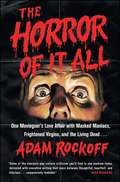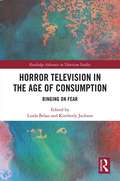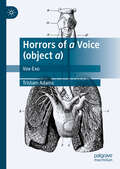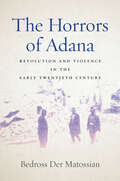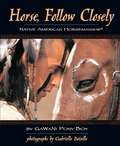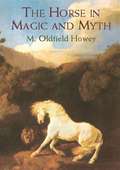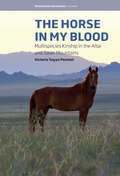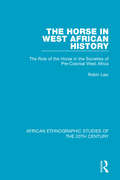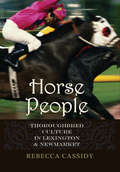- Table View
- List View
Horrible Mothers: Representations across Francophone North America
by Loïc BourdeauFor too long the main narratives of motherhood have been oppressive and exclusionary, frequently ignoring issues of female identity—especially regarding those not conforming to traditional female stereotypes. Horrible Mothers offers a variety of perspectives for analyzing representations of the mother in francophone literature and film at the turn of the twenty-first century in North America, including Québec, Ontario, New England, and California. Contributors reexamine the &“horrible mother&” paradigm within a broad range of sociocultural contexts from different locations to broaden the understanding of mothering beyond traditional ideology. The selections draw from long-established scholarship in women&’s studies as well as from new developments in queer studies to make sense of and articulate strategies of representation; to show how contemporary family models are constantly evolving, reshaping, and moving away from heteronormative expectations; and to reposition mothers as subjects occupying the center of their own narrative, rather than as objects. The contributors engage narratives of mothering from myriad perspectives, referencing the works of writers or filmmakers such as Marguerite Andersen, Nelly Arcan, Grégoire Chabot, Xavier Dolan, Nancy Huston, and Lucie Joubert.
Horrible Prettiness
by Robert C. AllenRobert Allen's compelling book examines burlesque not only as popular entertainment but also as a complex and transforming cultural phenomenon. When Lydia Thompson and her controversial female troupe of "British Blondes" brought modern burlesque to the United States in 1868, the result was electric. Their impertinent humor, streetwise manner, and provocative parodies of masculinity brought them enormous popular success--and the condemnation of critics, cultural commentators, and even women's rights campaigners.Burlesque was a cultural threat, Allen argues, because it inverted the "normal" world of middle-class social relations and transgressed norms of "proper" feminine behavior and appearance. Initially playing to respectable middle-class audiences, burlesque was quickly relegated to the shadow-world of working-class male leisure. In this process the burlesque performer "lost" her voice, as burlesque increasingly revolved around the display of her body.Locating burlesque within the context of both the social transformation of American theater and its patterns of gender representation, Allen concludes that burlesque represents a fascinating example of the potential transgressiveness of popular entertainment forms, as well as the strategies by which they have been contained and their threats defused.
Horrible White People: Gender, Genre, and Television's Precarious Whiteness
by Taylor Nygaard Jorie LagerweyExamines the bleak television comedies that illustrate the obsession of the white left with its own anxiety and sufferingAt the same time that right-wing political figures like Donald Trump were elected and reactionary socio-economic policies like Brexit were voted into law, representations of bleakly comic white fragility spread across television screens. American and British programming that featured the abjection of young, middle-class, liberal white people—such as Broad City, Casual, You’re the Worst, Catastrophe, Fleabag, and Transparent—proliferated to wide popular acclaim in the 2010s. Taylor Nygaard and Jorie Lagerwey track how these shows of the white left, obsessed with its own anxiety and suffering, are complicit in the rise and maintenance of the far right—particularly in the mobilization, representation, and sustenance of structural white supremacy on television.Nygaard and Lagerwey examine a cycle of dark television comedies, the focus of which are “horrible white people,” by putting them in conversation with similar upmarket comedies from creators and casts of color like Insecure, Atlanta, Dear White People, and Master of None. Through their analysis, they demonstrate the ways these non-white-centric shows negotiate prestige TV’s dominant aesthetics of whiteness and push back against the centering of white suffering in a time of cultural crisis.Through the lens of media analysis and feminist cultural studies, Nygaard and Lagerwey’s book opens up new ways of looking at contemporary television consumption—and the political, cultural, and social repercussions of these “horrible white people” shows, both on- and off-screen.
A Horrid History of Christmas: Horrible Happenings and Frightening Festivities
by Nicola SlyThis collection of historic horrid happenings from across the country demonstrates that Christmas is not necessarily a time of peace, joy and goodwill to all men. Festive tragedies include the avalanche in Lewes, which destroyed several cottages in 1836, killing eight of the occupants and injuring many more, and the fall of a chimney in Bradford in 1882, which claimed fifty-four lives. There are fatal rail crashes in Oxfordshire, Bedfordshire, Cheshire, Cumbria and Scotland; freak weather conditions and devastating fires, such as the Christmas Eve fire in Glasgow that cost the lives of four firemen in 1927. The holiday season has witnessed a plethora of almost unbelievable accidents, such as the amateur mechanic who died with his head stuck in a car engine, the footballer who leaped into a quarry to retrieve a lost ball, and the Christmas party guest who fell down a flight of stairs and broke his neck. Among the chilling crimes featured here is that of Nottinghamshire man Edward Kesteven, who killed his wife on Christmas Day 1894, and the murder of Thirza Kelly in Norfolk by a local teenager on Christmas Eve 1900. Full of merry madness and hearty heartache, A Horrid History of Christmas will make you want to bypass the festivities altogether!
Horror (Routledge Film Guidebooks)
by Brigid CherryHorror cinema is a hugely successful, but at the same time culturally illicit genre that spans the history of cinema. It continues to flourish with recent cycles of supernatural horror and torture porn that span the full range of horror styles and aesthetics. It is enjoyed by audiences everywhere, but also seen as a malign influence by others. In this Routledge Film Guidebook, audience researcher and film scholar Brigid Cherry provides a comprehensive overview of the horror film and explores how the genre works. Examining the way horror films create images of gore and the uncanny through film technology and effects, Cherry provides an account of the way cinematic and stylistic devices create responses of terror and disgust in the viewer. Horror examines the way these films construct psychological and cognitive responses and how they speak to audiences on an intimate personal level, addressing their innermost fears and desires. Cherry further explores the role of horror cinema in society and culture, looking at how it represents various identity groups and engages with social anxieties, and examining the way horror sees, and is seen by, society.
Horror and Science Fiction Cinema and Society: American Culture and Politics in the Cold War and After Through the Projector Lens
by Martin HarrisExamining how horror and science fiction films from the 1950s to the present invent and explore fictional “us-versus-them” scenarios, this book analyzes the different ways such films employ allegory and/or satire to interrogate the causes and consequences of increasing polarization in American politics and society.Starting with the killer ants film with an anti-communist subtext Them! (1954) and concluding with Jordan Peele’s social horror film with revenge-seeking homicidal doppelgängers Us (2019), Martin Harris highlights social and political contexts, contemporary reviews and responses, and retrospective evaluations to show how American horror and science fiction films reflect and respond to contemporary conflicts marking various periods in U.S. history from post-WWII to the present, including those concerning race, gender, class, faith, political ideology, national identity, and other elements of American society.Horror and Science Fiction Cinema and Society draws upon cinematic sociology to provide a resourceful approach to American horror and science fiction films that integrates discussion of plot construction and character development with analyses of the thematic uses of conflict, guiding readers’ understanding of how filmmakers create otherworldly confrontations to deliver real-world social and political commentary.
The Horror Film
by Peter HutchingsThe Horror Film is an in-depth exploration of one of the most consistently popular, but also most disreputable, of all the mainstream film genres. Since the early 1930s there has never been a time when horror films were not being produced in substantial numbers somewhere in the world and never a time when they were not being criticised, censored or banned. The Horror Film engages with the key issues raised by this most contentious of genres. It considers the reasons for horror's disreputability and seeks to explain why despite this horror has been so successful. Where precisely does the appeal of horror lie? An extended introductory chapter identifies what it is about horror that makes the genre so difficult to define. The chapter then maps out the historical development of the horror genre, paying particular attention to the international breadth and variety of horror production, with reference to films made in the United States, Britain, Italy, Spain and elsewhere. Subsequent chapters explore: The role of monsters, focusing on the vampire and the serial killer. The usefulness (and limitations) of psychological approaches to horror. The horror audience: what kind of people like horror (and what do other people think of them)? Gender, race and class in horror: how do horror films such as Bride of Frankenstein, The Texas Chainsaw Massacre and Blade relate to the social and political realities within which they are produced? Sound and horror: in what ways has sound contributed to the development of horror? Performance in horror: how have performers conveyed fear and terror throughout horror's history? 1970s horror: was this the golden age of horror production? Slashers and post-slashers: from Halloween to Scream and beyond. The Horror Film throws new light on some well-known horror films but also introduces the reader to examples of noteworthy but more obscure horror work. A final section provides a guide to further reading and an extensive bibliography. Accessibly written, The Horror Film is a lively and informative account of the genre that will appeal to students of cinema, film teachers and researchers, and horror lovers everywhere.
Horror Film and Affect: Towards a Corporeal Model of Viewership (Routledge Advances in Film Studies)
by Xavier Aldana ReyesThis book brings together various theoretical approaches to Horror that have received consistent academic attention since the 1990s – abjection, disgust, cognition, phenomenology, pain studies – to make a significant contribution to the study of fictional moving images of mutilation and the ways in which human bodies are affected by those on the screen on three levels: representationally, emotionally and somatically. Aldana Reyes reads Horror viewership as eminently carnal, and seeks to articulate the need for an alternative model that understands the experience of feeling under corporeal threat as the genre’s main descriptor. Using recent, post-millennial examples throughout, the book also offers case studies of key films such as Hostel, [REC], Martyrs or Ginger Snaps, and considers contemporary Horror strands such as found footage or 3D Horror.
Horror, The Film Reader (In Focus: Routledge Film Readers)
by Mark JancovichHorror, The Film Reader brings together key articles to provide a comprehensive resource for students of horror cinema. Mark Jancovich's introduction traces the development of horror film from The Cabinet of Dr. Caligari to The Blair Witch Project, and outlines the main critical debates. Combining classic and recent articles, each section explores a central issue of horror film, and features an editor's introduction outlining the context of debates.
Horror Films: Current Research on Audience Preferences and Reactions (Routledge Communication Series)
by Iii James B. Weaver Ron TamburiniWhy do so many of us enjoy being told frightening stories? What are some of the consequences that result from such exposure? In light of the considerable popularity of horror films over the last three decades, these questions have become the focus of growing attention for many scholars. However, research on audience preferences for, and reactions to, horror films has been performed eclectically by investigators from varied theoretical and methodological backgrounds. As a result, the information has not been effectively integrated. This volume was written to address this problem and to position the study of audience responses to frightening fiction as a significant research topic.
Horror Franchise Cinema (Routledge Advances in Film Studies)
by Mark McKennaThis book explores horror film franchising from a broad range of interdisciplinary perspectives and considers the horror film’s role in the history of franchising and serial fiction. Comprising 12 chapters written by established and emerging scholars in the field, Horror Franchise Cinema redresses critical neglect toward horror film franchising by discussing the forces and factors governing its development across historical and contemporary terrain while also examining text and reception practices. Offering an introduction to the history of horror franchising, the chapters also examine key texts including Universal Studio monster films, Blumhouse production films, The Texas Chainsaw Massacre, A Nightmare on Elm Street, Alien, I Spit on Your Grave, Let the Right One In, Italian zombie films, anthology films, and virtual reality. A significant contribution to studies of horror cinema and film/media franchising from the 1930s to the present day, this book will be of interest to students and scholars of film studies, media and cultural studies, franchise studies, political economy, audience/reception studies, horror studies, fan studies, genre studies, production cultures, and film histories.
Horror in Architecture: The Reanimated Edition
by Joshua Comaroff Ong Ker-ShingA new edition of this extensive visual analysis of horror tropes and their architectural analogues Horror in Architecture presents an unflinching look at how horror genre tropes manifest in the built environment. Spanning the realms of art, design, literature, and film, this newly revised and expanded edition compiles examples from all areas of popular culture to form a visual anthology of the architectural uncanny. Rooted in the Romantic and Gothic treatment of horror as a serious aesthetic category, Horror in Architecture establishes incisive links between contemporary horror media and its parallel traits found in various architectural designs. Through chapters dedicated to distorted and monstrous buildings, abandoned spaces, extremes of scale, and other structural peculiarities, and featuring new essays on insurgent natures, blobs, and architectural puppets, this volume brings together diverse architectural anomalies and shows how their unsettling effects deepen our fascination with the unreal. Intended for both horror fans and students of visual culture, Horror in Architecture turns a unique lens on the relationship between the human body and the artificial landscapes it inhabits. Extensively illustrated with photographs, film stills, and diagrams, this book retrieves horror from the cultural fringes and demonstrates how its attributes permeate the modern condition and the material world.
The Horror in Hindi Cinema: Between the Mythic and the Monstrous
by Meraj Ahmed MubarkiThe book offers a lively and detailed analysis of the ideological subtext of Hindi Horror cinema. It unearths its codes and conventions, its relationship to spectatorship, the genre’s conjunctions and departures from Hollywood, and the unique features of Hindi horror. It posits the Hindi horror genre as a project of / for the ‘nation’ in the making.Analysing films from Mahal (1948) to Bhediya (2022), this book uncovers narrative strategies, frames unique approaches of investigation, and reviews the transformation taking place within the genre. It argues that Hindi horror cinema lies at the intersection of myths, competing ideologies, dominant socio-religious thoughts revealing three major strands of narrative constructs, each corresponding to the way the nation has been imagined at different times in post-colonial India. It establishes a theoretical framework of Hindi horror cinema, and demonstrates for the first time how this genre, with its subsets, provides a means to contemplate the nation.This volume will be useful to students, researchers and faculty members working in mass communication, journalism, political science, film studies, political sociology, gender / women studies, Culture studies and post-colonial Indian politics. It will also be an invaluable and interesting reading for those interested in South Asian popular culture studies.
Horror Noire: Blacks in American Horror Films from the 1890s to Present
by Robin R Means ColemanFrom King Kong to Candyman, the boundary-pushing genre of the horror film has always been a site for provocative explorations of race in American popular culture. In Horror Noire: Blacks in American Horror Films from 1890's to Present, Robin R. Means Coleman traces the history of notable characterizations of blackness in horror cinema, and examines key levels of black participation on screen and behind the camera. She argues that horror offers a representational space for black people to challenge the more negative, or racist, images seen in other media outlets, and to portray greater diversity within the concept of blackness itself. Horror Noire presents a unique social history of blacks in America through changing images in horror films. Throughout the text, the reader is encouraged to unpack the genre’s racialized imagery, as well as the narratives that make up popular culture’s commentary on race. Offering a comprehensive chronological survey of the genre, this book addresses a full range of black horror films, including mainstream Hollywood fare, as well as art-house films, Blaxploitation films, direct-to-DVD films, and the emerging U.S./hip-hop culture-inspired Nigerian "Nollywood" Black horror films. Horror Noire is, thus, essential reading for anyone seeking to understand how fears and anxieties about race and race relations are made manifest, and often challenged, on the silver screen.
The Horror of It All
by Adam RockoffPop culture history meets blood-soaked memoir as a horror film aficionado and screenwriter recalls a life spent watching blockbuster slasher films, cult classics, and everything in between. Horror films have simultaneously captivated and terrified audiences for generations, racking up billions of dollars at the box office and infusing our nightmares with unrelenting zombies, chainsaw-wielding madmen, and myriad incarnations of ghosts, ghouls, and the devil himself. Despite evolving modes of storytelling and the fluctuating popularity of other genres, horror endures. The Horror of It All is a memoir from the front lines of the industry that dissects (and occasionally defends) the hugely popular phenomenon of scary movies. Author Adam Rockoff traces the highs and lows of the horror genre through the lens of his own obsessive fandom, born in the aisles of his local video store and nurtured with a steady diet of cable trash. From Siskel and Ebert’s crusade against slasher films to horror’s Renaissance in the wake of Scream, Rockoff mines the rich history of the genre, braiding critical analysis with his own firsthand experiences. Be afraid. Be very afraid.
The Horror of Police
by Travis LinnemannUnmasks the horrors of a social order reproduced and maintained by the violence of police Year after year the crisis churns: graft and corruption, violence and murder, riot cops and armored vehicles claim city streets. Despite promises of reform, police operate with impunity, unaccountable to law. In The Horror of Police, Travis Linnemann asks why, with this open record of violence and corruption, policing remains for so many the best, perhaps only means of security in an insecure world. Drawing on the language and texts of horror fiction, Linnemann recasts the police not only as self-proclaimed &“monster fighters&” but as monsters themselves, a terrifying force set loose in the world. Purposefully misreading a collection of everyday police stories (TV cop dramas, detective fiction, news media accounts, the direct words of police) not as morality tales of innocence avenged and order restored but as horror, Linnemann reveals the monstrous violence at the heart of liberal social order. The Horror of Police shows that police violence is not a deviation but rather a deliberate and permanent fixture of U.S. &“law and order.&” Only when viewed through the refracted motif of horror stories, Linnemann argues, can we begin to reckon the limits of police and imagine a world without them.
Horror Television in the Age of Consumption: Binging on Fear (Routledge Advances in Television Studies)
by Kimberly Jackson Linda BelauCharacterized as it is by its interest in and engagement with the supernatural, psycho-social formations, the gothic, and issues of identity and subjectivity, horror has long functioned as an allegorical device for interrogations into the seamier side of cultural foundations. This collection, therefore, explores both the cultural landscape of this recent phenomenon and the reasons for these television series’ wide appeal, focusing on televisual aesthetics, technological novelties, the role of adaptation and seriality, questions of gender, identity and subjectivity, and the ways in which the shows’ themes comment on the culture that consumes them. Featuring new work by many of the field’s leading scholars, this collection offers innovative readings and rigorous theoretical analyses of some of our most significant contemporary texts in the genre of Horror Television.
Horrors of a Voice (object a): Vox-Exo
by Tristam AdamsThis book reframes the Lacanian object a voice as a horrific register of alterity. The object gaze has received, as it does in Jacques Lacan’s work, more commentary than voice. Yet recently voice has garnered interest from multiple disciplines. The book intervenes in the Slovenian school’s commentary of the ‘object voice’ in terms of two questions: audition and corporeality. This intervention synthesizes psychoanalysis with recent theorizing of the horror of philosophy. In this intervention the object a voice is argued to resonate in lacunae – epistemological voids that evoke horror in the subject. Biological and evolutionary perspectives on voice, genre horror film and literature, music videos, close readings of Freudian and Lacanian case studies and textual analysis of ancient philosophy texts all contribute to an elucidation of the horrors of the object a voice: Vox-Exo.
The Horrors of Adana: Revolution and Violence in the Early Twentieth Century
by Bedross Der MatossianIn April 1909, two waves of massacres shook the province of Adana, located in the southern Anatolia region of modern-day Turkey, killing more than 20,000 Armenians and 2,000 Muslims. The central Ottoman government failed to prosecute the main culprits, a miscarriage of justice that would have repercussions for years to come. Despite the significance of these events and the extent of violence and destruction, the Adana Massacres are often left out of historical narratives. The Horrors of Adana offers one of the first close examinations of these events, analyzing sociopolitical and economic transformations that culminated in a cataclysm of violence. Bedross Der Matossian provides voice and agency to all involved in the massacres—perpetrators, victims, and bystanders. Drawing on primary sources in a dozen languages, he develops an interdisciplinary approach to understand the rumors and emotions, public spheres and humanitarian interventions that together informed this complex event. Ultimately, through consideration of the Adana Massacres in micro-historical detail, this book offers an important macrocosmic understanding of ethnic violence, illuminating how and why ordinary people can become perpetrators.
Horse, Follow Closely
by Gawani Pony BoyThe bible of North American Horsemanship, Horse, Follow Closely is GaWaNi Pony Boy's signature title about the relationship training methods that are steeped in common sense and the age-old wisdom of his Native American ancestors. Of mixed blood Tsa-la-gi, GaWaNi Pony Boy was able to conceive his philosophy and compile the methods of relationship training while touring the United States with a Native American drum band and consulting the Tribal Elders from many different nations and backgrounds. The methods and beliefs of relationship training come directly from the first great horsemen of North America. "Horse and rider are one. Theirs is a relationship of trust, harmony, and respect born of a way of life that is all but lost." The stunning full-color photographs by Gabrielle Boiselle capture Pony Boy's serenity and unity with his close horse companions. The author's simple eloquence forges a deep, profound relationship with his readers that few books ever hope to achieve. As Pony Boy writes in the introduction, "For many [the Native American horseman] represents the ultimate rider. The essence of a horseman, both his skill and intuition, goes beyond the hours he spends in the saddle....the folklore of every Native tribe are stories, tales, and beliefs to exemplify human's relations to other animals." The book begins with an analysis of how horses came to live with the Natives of North America and horses' impact on Native life. The crux of relationship training, according to the author, is to understand "what it means to be a horse, react like a horse, and relate to other things like a horse...." Native Americans were able to create such strong relationship with horses in a short time because they understood that "a horse is a horse." Learning to balance the relationship between horse and human is the missing link to becoming a masterful horseman or horsewoman. The book describes not only the techniques involved for relationship training but also the belief system and attitude that must be applied to all methods of horsemanship.In addition to presenting the methods and philosophy of relationship training, Horse, Follow Closely also includes many stories and legends of Native Americans and their horses, all of which teach the reader something new about himself and his relationship with his horse.
Horse Girls: Recovering, Aspiring, and Devoted Riders Redefine the Iconic Bond
by Halimah Marcus“A wild, rollicking ride into the heart of horse country—these essays get at what it means to love horses, in all that love's complexity.” —Anton DiSclafani, author of The Yonahlossee Riding Camp for GirlsA compelling and provocative essay collection that smashes stereotypes and redefines the meaning of the term “horse girl,” broadening it for women of all cultural backgrounds.As a child, horses consumed Halimah Marcus’ imagination. When she wasn’t around horses she was pretending to be one, cantering on two legs, hands poised to hold invisible reins. To her classmates, girls like Halimah were known as “horse girls,” weird and overzealous, absent from the social worlds of their peers. Decades later, when memes about “horse girl energy,” began appearing across social media—Halimah reluctantly recognized herself. The jokes imagine girls as blinkered as carriage ponies, oblivious to the mockery behind their backs. The stereotypical horse girl is also white, thin, rich, and straight, a daughter of privilege. Yet so many riders don’t fit this narrow, damaging ideal, and relate to horses in profound ways that include ambivalence and regret, as well as unbridled passion and devotion.Featuring some of the most striking voices in contemporary literature—including Carmen Maria Machado, Pulitzer-prize winner Jane Smiley, T Kira Madden, Maggie Shipstead, and Courtney Maum—Horse Girls reframes the iconic bond between girls and horses with the complexity and nuance it deserves. And it showcases powerful emerging voices like Braudie Blais-Billie, on the connection between her Seminole and Quebecois heritage; Sarah Enelow-Snyder, on growing up as a Black barrel racer in central Texas; and Nur Nasreen Ibrahim, on the colonialist influence on horse culture in Pakistan.By turns thought-provoking and personal, Horse Girls reclaims its titular stereotype to ask bold questions about autonomy and desire, privilege and ambition, identity and freedom, and the competing forces of domestication and wildness.
The Horse in Magic and Myth
by M. Oldfield HoweyFrom Pegasus and the Trojan horse to the four horses of the Apocalypse, the familiar figure of the horse possesses an age-old mystique. Indeed, many cultures around the world attribute otherworldly qualities to the horse. This volume provides a rich compilation of legend and lore celebrating the sacred and magical symbolism traditionally associated with horses.Derived from classical mythology, the Bible, world folklore, literature, and other sources, these fantastic tales recount the exploits of angelic steeds and demonic horses as well as centaurs, hippogryphs, and unicorns. Supernatural warhorses and headless phantom horses gallop through these stories, in addition to fairy horses, sea horses, hobbyhorses, bridal horses, corn-horses, moon-horses, wind-horses, and many other fabulous equine exemplars. Readers will also find legends of the gods and patron saints of horses, the horse and metempsychosis, the horse in creation myths, and much more.A bibliography appears at the end of each chapter, providing scholars and folklorists with an excellent range of resources. The informal and colorful narrative, enhanced by several fanciful illustrations, makes this unique book a treat for horse lovers and readers of all interests.
The Horse in My Blood: Multispecies Kinship in the Altai and Saian Mountains (Interspecies Encounters #4)
by Victoria Soyan PeemotA fascinating interspecies relationship can be seen among the horse breeding pastoralists in the Altai and Saian Mountains of Inner Asia. Victoria Soyan Peemot herself grew up in a community with close human-horse relationships and uses her knowledge of the local language and horsemanship practices. Building upon Indigenous research epistemologies, she engages with the study of how the human-horse relationships interact with each other, experience injustices and develop resilience strategies as multispecies unions.
The Horse in West African History: The Role of the Horse in the Societies of Pre-Colonial West Africa
by Robin LawOriginally published in 1980 and here re-issued with an updated preface, this book deals with the role of the horse in the societies of West Africa during the pre-colonial period. It traces the history of its introduction and its diffusion within West Africa, and examines the problems of maintaining horses in such a harsh environment. The use of horses in warfare in analysed but the non-military aspects of the West African horse culture are also discussed, principally the use of horses as tokens of status and wealth. The book includes a review of the decline of the West African horse culture in the 20th century, reflecting the passing of a political system based on warfare and slavery.
Horse People: Thoroughbred Culture in Lexington and Newmarket (Animals, History, Culture)
by Rebecca Louise CassidyThe world of Thoroughbred racing is glamorous, secretive, dangerous, and seductive—the sport of kings and the poor man's obsession. While the spectacle of racing stirs the imagination, it belies the ruthless business that lies beneath.This engaging original study demystifies this complex world by comparing centers of excellence in Britain and North America. Drawing from intensive field work in Suffolk's Newmarket and Kentucky's Lexington, Rebecca Cassidy gives us the inside track on all players in the industry—from the elite breeders and owners to the stable boys, racetrack workers, and veterinarians. She leads us through horse farms, breeding barns, and yearling sales; explains rigorous training regimens; and brings us trackside on race day.But the history of Thoroughbred racing culture is more than a collection of fascinating characters and exciting events. Cassidy's investigation reveals the factors—ethical, cultural, political, and economic—that have shaped the racing tradition.

